THE GREAT CATHERINE PARK Upper Bath


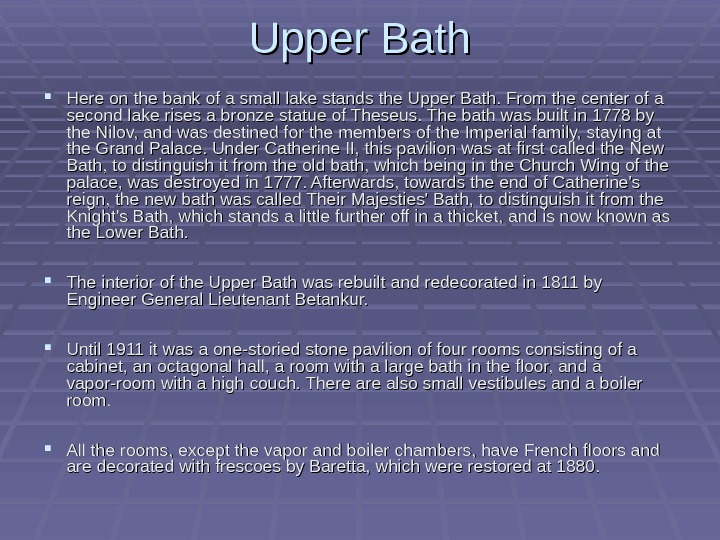
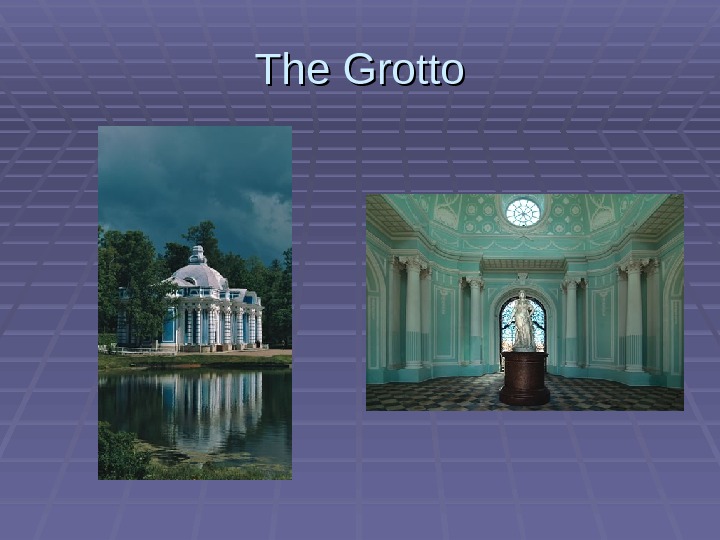


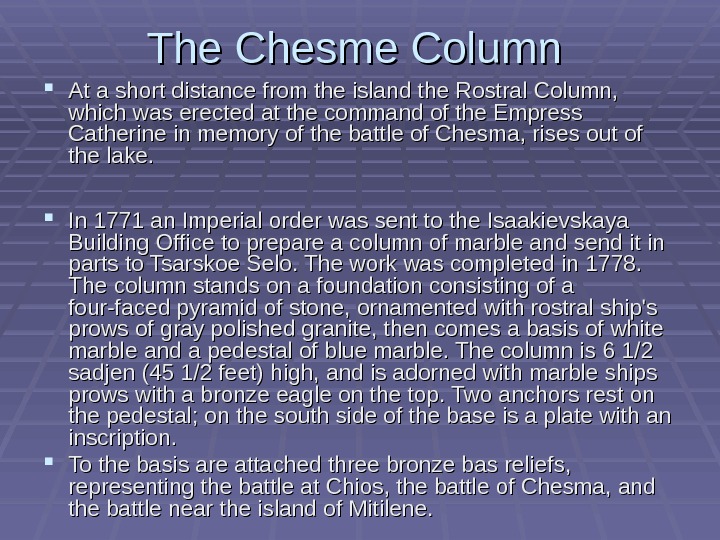
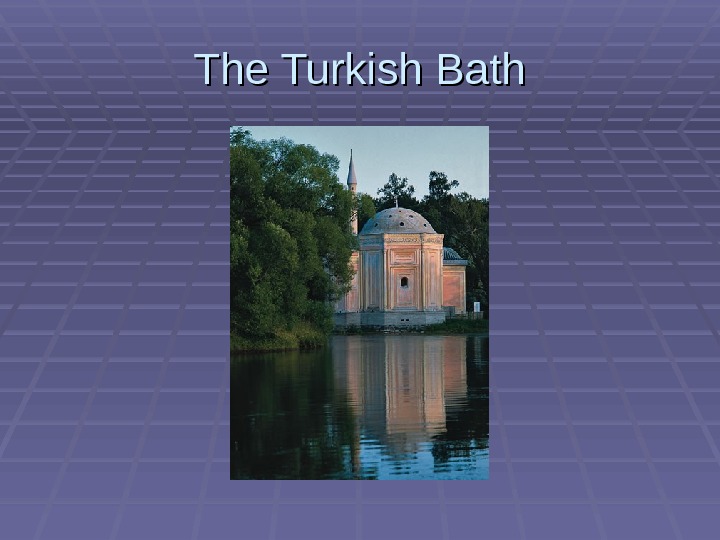
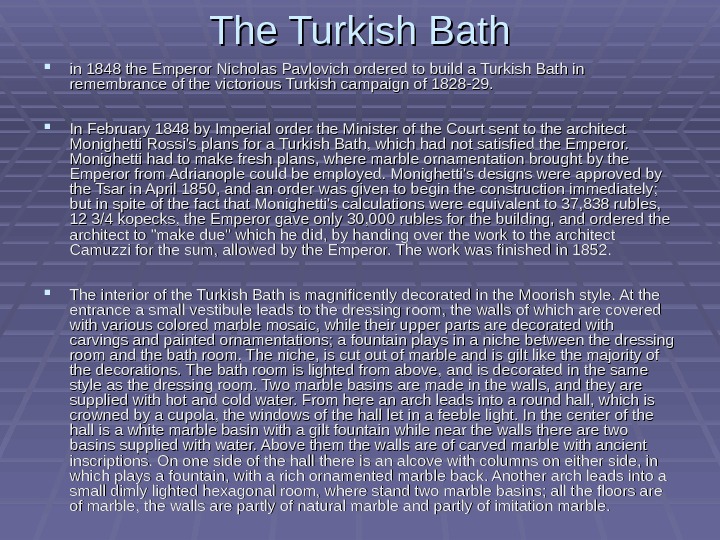
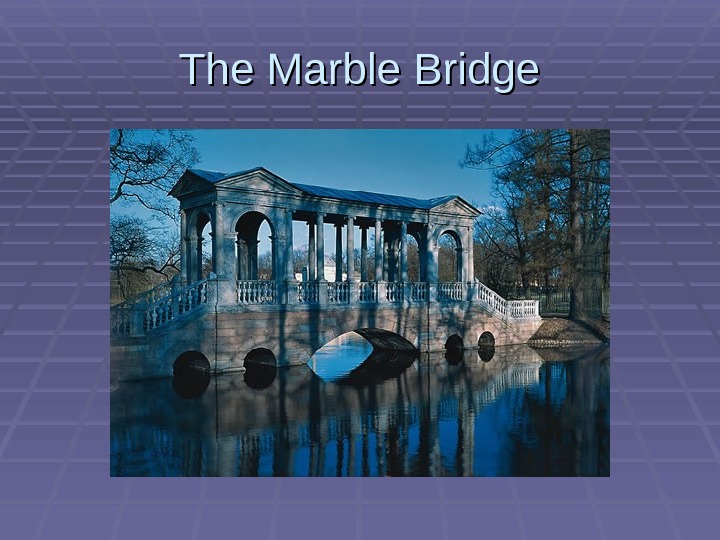
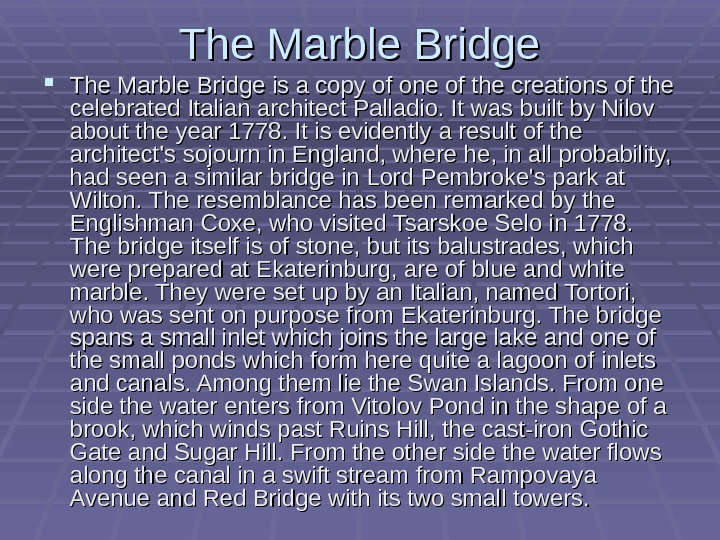



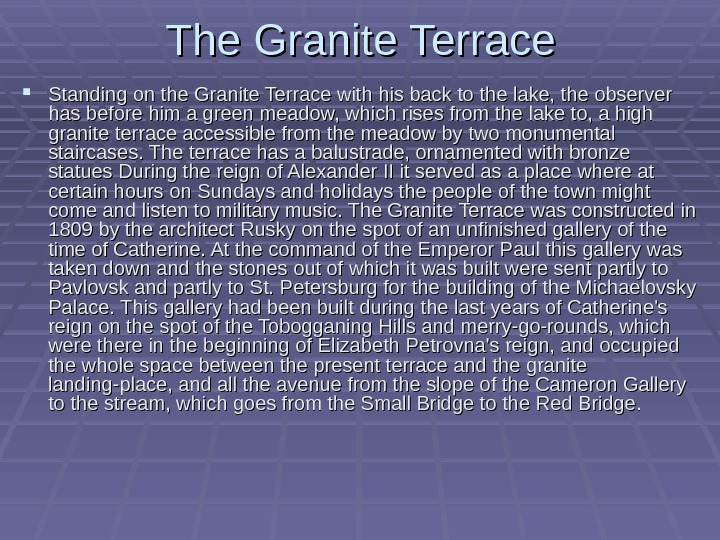
- Размер: 501 Кб
- Количество слайдов: 15
Описание презентации THE GREAT CATHERINE PARK Upper Bath по слайдам
 THE GREAT CATHERINE PARK
THE GREAT CATHERINE PARK
 Upper Bath
Upper Bath
 Upper Bath Here on the bank of a small lake stands the Upper Bath. From the center of a second lake rises a bronze statue of Theseus. The bath was built in 1778 by the Nilov, and was destined for the members of the Imperial family, staying at the Grand Palace. Under Catherine II, this pavilion was at first called the New Bath, to distinguish it from the old bath, which being in the Church Wing of the palace, was destroyed in 1777. Afterwards, towards the end of Catherine’s reign, the new bath was called Their Majesties’ Bath, to distinguish it from the Knight’s Bath, which stands a little further off in a thicket, and is now known as the Lower Bath. The interior of the Upper Bath was rebuilt and redecorated in 1811 by Engineer General Lieutenant Betankur. Until 1911 it was a one-storied stone pavilion of four rooms consisting of a cabinet, an octagonal hall, a room with a large bath in the floor, and a vapor-room with a high couch. There are also small vestibules and a boiler room. All the rooms, except the vapor and boiler chambers, have French floors and are decorated with frescoes by Baretta, which were restored at 1880.
Upper Bath Here on the bank of a small lake stands the Upper Bath. From the center of a second lake rises a bronze statue of Theseus. The bath was built in 1778 by the Nilov, and was destined for the members of the Imperial family, staying at the Grand Palace. Under Catherine II, this pavilion was at first called the New Bath, to distinguish it from the old bath, which being in the Church Wing of the palace, was destroyed in 1777. Afterwards, towards the end of Catherine’s reign, the new bath was called Their Majesties’ Bath, to distinguish it from the Knight’s Bath, which stands a little further off in a thicket, and is now known as the Lower Bath. The interior of the Upper Bath was rebuilt and redecorated in 1811 by Engineer General Lieutenant Betankur. Until 1911 it was a one-storied stone pavilion of four rooms consisting of a cabinet, an octagonal hall, a room with a large bath in the floor, and a vapor-room with a high couch. There are also small vestibules and a boiler room. All the rooms, except the vapor and boiler chambers, have French floors and are decorated with frescoes by Baretta, which were restored at 1880.
 The Grotto
The Grotto
 The Grotto To the right of the chief dam is an exquisite little one storied building with a landing place in front of it. This is the Grotto or Morning Hall. The Grotto was built during the reign of the Empress Elizabeth Petrovna in 1755 -56. This construction, as well as the interior decorations, was carried out by an Italian, Rossi, under the supervision of Rastrelli. At that time it was the fashion to adorn rooms in palaces, or pavilions in parks, with shells. Such a room existed in the Great Catherine Palace, but it was abolished on account of its being damp. The shells from it were salvaged for decorating the new pavilion, thus turning it into a grotto. The adornment of the Grotto required 210, 000 large shells and nearly 17 1/2 poods of small ones. Thus decorated and with a stone balustrade round its roof of tin plated iron, the Grotto existed till 1770, when the Empress Catherine ordered the balustrade to be removed, the shells to be taken away, and the interior to be finished with simple grotto square work. During the reign of Catherine the was used as a place for storing antique works of art. In the descriptions of Tsarskoe Selo in the 18 th century, and in engravings of the period, the Grotto is called the Hall of Antiques. At the close of Catherine’s reign a multitude of statues, molds, old inscriptions and Houdon’s marble statue of Voltaire, sitting in a chair, were kept in the Grotto. Among the huge number of antique works of art, there were many objects of comparatively small worth.
The Grotto To the right of the chief dam is an exquisite little one storied building with a landing place in front of it. This is the Grotto or Morning Hall. The Grotto was built during the reign of the Empress Elizabeth Petrovna in 1755 -56. This construction, as well as the interior decorations, was carried out by an Italian, Rossi, under the supervision of Rastrelli. At that time it was the fashion to adorn rooms in palaces, or pavilions in parks, with shells. Such a room existed in the Great Catherine Palace, but it was abolished on account of its being damp. The shells from it were salvaged for decorating the new pavilion, thus turning it into a grotto. The adornment of the Grotto required 210, 000 large shells and nearly 17 1/2 poods of small ones. Thus decorated and with a stone balustrade round its roof of tin plated iron, the Grotto existed till 1770, when the Empress Catherine ordered the balustrade to be removed, the shells to be taken away, and the interior to be finished with simple grotto square work. During the reign of Catherine the was used as a place for storing antique works of art. In the descriptions of Tsarskoe Selo in the 18 th century, and in engravings of the period, the Grotto is called the Hall of Antiques. At the close of Catherine’s reign a multitude of statues, molds, old inscriptions and Houdon’s marble statue of Voltaire, sitting in a chair, were kept in the Grotto. Among the huge number of antique works of art, there were many objects of comparatively small worth.
 The Chesme Column
The Chesme Column
 The Chesme Column At a short distance from the island the Rostral Column, which was erected at the command of the Empress Catherine in memory of the battle of Chesma, rises out of the lake. In 1771 an Imperial order was sent to the Isaakievskaya Building Office to prepare a column of marble and send it in parts to Tsarskoe Selo. The work was completed in 1778. The column stands on a foundation consisting of a four-faced pyramid of stone, ornamented with rostral ship’s prows of gray polished granite, then comes a basis of white marble and a pedestal of blue marble. The column is 6 1/2 sadjen (45 1/2 feet) high, and is adorned with marble ships prows with a bronze eagle on the top. Two anchors rest on the pedestal; on the south side of the base is a plate with an inscription. To the basis are attached three bronze bas reliefs, representing the battle at Chios, the battle of Chesma, and the battle near the island of Mitilene.
The Chesme Column At a short distance from the island the Rostral Column, which was erected at the command of the Empress Catherine in memory of the battle of Chesma, rises out of the lake. In 1771 an Imperial order was sent to the Isaakievskaya Building Office to prepare a column of marble and send it in parts to Tsarskoe Selo. The work was completed in 1778. The column stands on a foundation consisting of a four-faced pyramid of stone, ornamented with rostral ship’s prows of gray polished granite, then comes a basis of white marble and a pedestal of blue marble. The column is 6 1/2 sadjen (45 1/2 feet) high, and is adorned with marble ships prows with a bronze eagle on the top. Two anchors rest on the pedestal; on the south side of the base is a plate with an inscription. To the basis are attached three bronze bas reliefs, representing the battle at Chios, the battle of Chesma, and the battle near the island of Mitilene.
 The Turkish Bath
The Turkish Bath
 The Turkish Bath in 1848 the Emperor Nicholas Pavlovich ordered to build a Turkish Bath in remembrance of the victorious Turkish campaign of 1828 -29. In February 1848 by Imperial order the Minister of the Court sent to the architect Monighetti Rossi’s plans for a Turkish Bath, which had not satisfied the Emperor. Monighetti had to make fresh plans, where marble ornamentation brought by the Emperor from Adrianople could be employed. Monighetti’s designs were approved by the Tsar in April 1850, and an order was given to begin the construction immediately; but in spite of the fact that Monighetti’s calculations were equivalent to 37, 838 rubles, 12 3/4 kopecks, the Emperor gave only 30, 000 rubles for the building, and ordered the architect to «make due» which he did, by handing over the work to the architect Camuzzi for the sum, allowed by the Emperor. The work was finished in 1852. The interior of the Turkish Bath is magnificently decorated in the Moorish style. At the entrance a small vestibule leads to the dressing room, the walls of which are covered with various colored marble mosaic, while their upper parts are decorated with carvings and painted ornamentations; a fountain plays in a niche between the dressing room and the bath room. The niche, is cut out of marble and is gilt like the majority of the decorations. The bath room is lighted from above, and is decorated in the same style as the dressing room. Two marble basins are made in the walls, and they are supplied with hot and cold water. From here an arch leads into a round hall, which is crowned by a cupola, the windows of the hall let in a feeble light. In the center of the hall is a white marble basin with a gilt fountain while near the walls there are two basins supplied with water. Above them the walls are of carved marble with ancient inscriptions. On one side of the hall there is an alcove with columns on either side, in which plays a fountain, with a rich ornamented marble back. Another arch leads into a small dimly lighted hexagonal room, where stand two marble basins; all the floors are of marble, the walls are partly of natural marble and partly of imitation marble.
The Turkish Bath in 1848 the Emperor Nicholas Pavlovich ordered to build a Turkish Bath in remembrance of the victorious Turkish campaign of 1828 -29. In February 1848 by Imperial order the Minister of the Court sent to the architect Monighetti Rossi’s plans for a Turkish Bath, which had not satisfied the Emperor. Monighetti had to make fresh plans, where marble ornamentation brought by the Emperor from Adrianople could be employed. Monighetti’s designs were approved by the Tsar in April 1850, and an order was given to begin the construction immediately; but in spite of the fact that Monighetti’s calculations were equivalent to 37, 838 rubles, 12 3/4 kopecks, the Emperor gave only 30, 000 rubles for the building, and ordered the architect to «make due» which he did, by handing over the work to the architect Camuzzi for the sum, allowed by the Emperor. The work was finished in 1852. The interior of the Turkish Bath is magnificently decorated in the Moorish style. At the entrance a small vestibule leads to the dressing room, the walls of which are covered with various colored marble mosaic, while their upper parts are decorated with carvings and painted ornamentations; a fountain plays in a niche between the dressing room and the bath room. The niche, is cut out of marble and is gilt like the majority of the decorations. The bath room is lighted from above, and is decorated in the same style as the dressing room. Two marble basins are made in the walls, and they are supplied with hot and cold water. From here an arch leads into a round hall, which is crowned by a cupola, the windows of the hall let in a feeble light. In the center of the hall is a white marble basin with a gilt fountain while near the walls there are two basins supplied with water. Above them the walls are of carved marble with ancient inscriptions. On one side of the hall there is an alcove with columns on either side, in which plays a fountain, with a rich ornamented marble back. Another arch leads into a small dimly lighted hexagonal room, where stand two marble basins; all the floors are of marble, the walls are partly of natural marble and partly of imitation marble.
 The Marble Bridge
The Marble Bridge
 The Marble Bridge is a copy of one of the creations of the celebrated Italian architect Palladio. It was built by Nilov about the year 1778. It is evidently a result of the architect’s sojourn in England, where he, in all probability, had seen a similar bridge in Lord Pembroke’s park at Wilton. The resemblance has been remarked by the Englishman Coxe, who visited Tsarskoe Selo in 1778. The bridge itself is of stone, but its balustrades, which were prepared at Ekaterinburg, are of blue and white marble. They were set up by an Italian, named Tortori, who was sent on purpose from Ekaterinburg. The bridge spans a small inlet which joins the large lake and one of the small ponds which form here quite a lagoon of inlets and canals. Among them lie the Swan Islands. From one side the water enters from Vitolov Pond in the shape of a brook, which winds past Ruins Hill, the cast-iron Gothic Gate and Sugar Hill. From the other side the water flows along the canal in a swift stream from Rampovaya Avenue and Red Bridge with its two small towers.
The Marble Bridge is a copy of one of the creations of the celebrated Italian architect Palladio. It was built by Nilov about the year 1778. It is evidently a result of the architect’s sojourn in England, where he, in all probability, had seen a similar bridge in Lord Pembroke’s park at Wilton. The resemblance has been remarked by the Englishman Coxe, who visited Tsarskoe Selo in 1778. The bridge itself is of stone, but its balustrades, which were prepared at Ekaterinburg, are of blue and white marble. They were set up by an Italian, named Tortori, who was sent on purpose from Ekaterinburg. The bridge spans a small inlet which joins the large lake and one of the small ponds which form here quite a lagoon of inlets and canals. Among them lie the Swan Islands. From one side the water enters from Vitolov Pond in the shape of a brook, which winds past Ruins Hill, the cast-iron Gothic Gate and Sugar Hill. From the other side the water flows along the canal in a swift stream from Rampovaya Avenue and Red Bridge with its two small towers.
 The Hermitage
The Hermitage
 The Hermitage Rastrelli began to build the Hermitage in 1746. The Hermitage is a two-storied stone building, in the center of which is a large hall with four galleries and small pavilions at their ends. The lower story is occupied by kitchens and servants’ quarters. One can ascend to the hall from the lower story by means of an elevator or by means of a narrow staircase. The upper story is luxuriously decorated with gilt-carving and stucco-work in Rococo style, the painted ceilings are the work of Valeriani, the Gradizzi (father and son) and Peresinotti. The peculiarity of the Hermitage consists in the fact, that it was built for dinners, at which no servants were to be present. With the help of an ingenious mechanism five tables can be lifted from the lower story. These tables have special elevators for plates and dishes, which are provided on their tops with slates. All one has to do is to write the order on the slate and to pull a string; the plate disappears; the servant below places the required food or drink on a tray and raises it to the table. 35 persons sit at table at the same time. If the guests at the Hermitage, wished to dance before supper or after dinner, at a given signal all the tables sunk, as by magic, an inlaid French floor took their place, and the dining room was quickly converted into a ballroom.
The Hermitage Rastrelli began to build the Hermitage in 1746. The Hermitage is a two-storied stone building, in the center of which is a large hall with four galleries and small pavilions at their ends. The lower story is occupied by kitchens and servants’ quarters. One can ascend to the hall from the lower story by means of an elevator or by means of a narrow staircase. The upper story is luxuriously decorated with gilt-carving and stucco-work in Rococo style, the painted ceilings are the work of Valeriani, the Gradizzi (father and son) and Peresinotti. The peculiarity of the Hermitage consists in the fact, that it was built for dinners, at which no servants were to be present. With the help of an ingenious mechanism five tables can be lifted from the lower story. These tables have special elevators for plates and dishes, which are provided on their tops with slates. All one has to do is to write the order on the slate and to pull a string; the plate disappears; the servant below places the required food or drink on a tray and raises it to the table. 35 persons sit at table at the same time. If the guests at the Hermitage, wished to dance before supper or after dinner, at a given signal all the tables sunk, as by magic, an inlaid French floor took their place, and the dining room was quickly converted into a ballroom.
 The Granite Terrace
The Granite Terrace
 The Granite Terrace Standing on the Granite Terrace with his back to the lake, the observer has before him a green meadow, which rises from the lake to, a high granite terrace accessible from the meadow by two monumental staircases. The terrace has a balustrade, ornamented with bronze statues During the reign of Alexander II it served as a place where at certain hours on Sundays and holidays the people of the town might come and listen to military music. The Granite Terrace was constructed in 1809 by the architect Rusky on the spot of an unfinished gallery of the time of Catherine. At the command of the Emperor Paul this gallery was taken down and the stones out of which it was built were sent partly to Pavlovsk and partly to St. Petersburg for the building of the Michaelovsky Palace. This gallery had been built during the last years of Catherine’s reign on the spot of the Tobogganing Hills and merry-go-rounds, which were there in the beginning of Elizabeth Petrovna’s reign, and occupied the whole space between the present terrace and the granite landing-place, and all the avenue from the slope of the Cameron Gallery to the stream, which goes from the Small Bridge to the Red Bridge.
The Granite Terrace Standing on the Granite Terrace with his back to the lake, the observer has before him a green meadow, which rises from the lake to, a high granite terrace accessible from the meadow by two monumental staircases. The terrace has a balustrade, ornamented with bronze statues During the reign of Alexander II it served as a place where at certain hours on Sundays and holidays the people of the town might come and listen to military music. The Granite Terrace was constructed in 1809 by the architect Rusky on the spot of an unfinished gallery of the time of Catherine. At the command of the Emperor Paul this gallery was taken down and the stones out of which it was built were sent partly to Pavlovsk and partly to St. Petersburg for the building of the Michaelovsky Palace. This gallery had been built during the last years of Catherine’s reign on the spot of the Tobogganing Hills and merry-go-rounds, which were there in the beginning of Elizabeth Petrovna’s reign, and occupied the whole space between the present terrace and the granite landing-place, and all the avenue from the slope of the Cameron Gallery to the stream, which goes from the Small Bridge to the Red Bridge.
